Reclaim Waste Things To Know Before You Buy
Reclaim Waste Things To Know Before You Buy
Blog Article
The Single Strategy To Use For Reclaim Waste
Table of ContentsSome Known Facts About Reclaim Waste.Reclaim Waste Fundamentals ExplainedWhat Does Reclaim Waste Mean?Reclaim Waste - TruthsAbout Reclaim Waste
Domestic sewage waste refers to the waste and items from a household septic tank. The appropriate monitoring and disposal of domestic sewer waste need fluid waste to be transferred to a sewer treatment plant where the proper methods and tools are used to purify and dispose of waste.
Industrial waste commonly includes possible threats, such as combustible products or a combination of liquid and strong waste products, and requires an advanced and comprehensive disposal procedure. The disposal of industrial waste generally includes the filtration of waste before transport to make certain risk-free and correct disposal. Hazardous waste is produced from byproducts and runoff of industrial procedures and production.
This kind of waste can not make use of the very same sewage administration transport or processes as septic or industrial liquids. The hazardous waste monitoring process needs the evaluation and testing of fluid waste before it undergoes the disposal process (industrial wastewater treatment). Overflow waste is the liquid waste that originates from runoff and excess stormwater in very booming locations or cities
Drainage waste can cause contamination and flooding if not handled effectively. Ensuring appropriate waste monitoring can stop disasters and lower environmental injury.
Indicators on Reclaim Waste You Need To Know
Call PROS Solutions today to learn more about our waste monitoring and disposal solutions and the proper means to care for the fluid waste you create.
(https://www.huntingnet.com/forum/members/reclaimwaste1.html)Do you recognize what takes place to your water when you draw the plug, purge the bathroom or drain pipes the washing device? No? Well, it's worth recognizing. This supposed 'wastewater' is not only a crucial resource however, after treatment, will be launched to our land, waterways or the sea. Made use of water from commodes, showers, bathrooms, kitchen sinks, laundries and industrial processes is known as wastewater.

water used to cool down machinery or clean plant and devices). Stormwater, a type of wastewater, is overflow that streams from farming and urban areas such as roofs, parks, yards, roads, courses and rain gutters right into stormwater drains pipes, after rainfall. Stormwater streams unattended straight to local creeks or rivers, at some point reaching the ocean.
Facts About Reclaim Waste Uncovered
In Queensland, most wastewater is treated at sewage treatment plants. Wastewater is delivered from residential or industrial websites via a system of sewage systems and pump stations, called sewerage reticulation, to a sewage treatment plant. Neighborhood governments construct, maintain and run most sewage therapy plants. Operators are accredited under the Environmental Security Act 1994 to release treated wastewater at an appropriate environmental criterion into rivers.
The Department of Natural Resources suggests city governments concerning managing, operating and maintaining sewerage systems and treatment plants. In unsewered areas, regional federal governments may need owners to set up private or household sewage treatment systems to deal my company with residential wastewater from commodes, cooking areas, washrooms and laundries. The Department of Natural Resources authorises using family systems when they are shown to be reliable.
In some new subdivisions, therapy of some stormwater to get rid of litter, sand and crushed rock has actually started making use of gross contaminant traps. Wastewater therapy occurs in four stages: Gets rid of strong matter.
Wastewater after that moves into large storage tanks where solids work out and are gotten rid of as sludge. Oil and residue are skimmed from the surface. Utilizes little living organisms referred to as micro-organisms to break down and remove continuing to be dissolved wastes and great bits. Micro-organisms and wastes are included in the sludge. Removes nitrogen and phosphorus nutrients that could create algal blossoms in our waterways and intimidate aquatic life.
Rumored Buzz on Reclaim Waste
Nutrient removal is not readily available in any way sewage treatment plants due to the fact that it needs costly specialist equipment. It is becoming extra common in Queensland. Clear fluid effluent produced after therapy might still contain disease-causing micro-organisms. If this effluent is launched into rivers such as rivers or the sea, the micro-organisms will eventually pass away out.

The majority of wastewater moves into the sewage system. Under the Act, regional governments provide authorizations and permits for environmentally pertinent tasks (Periods) involving wastewater launches that may have a neighborhood effect.
The Only Guide for Reclaim Waste
Monitoring gives valid details regarding water quality and can confirm that permit conditions are being met. The details acquired via monitoring supplies the basis for making water high quality decisions.
Report this page